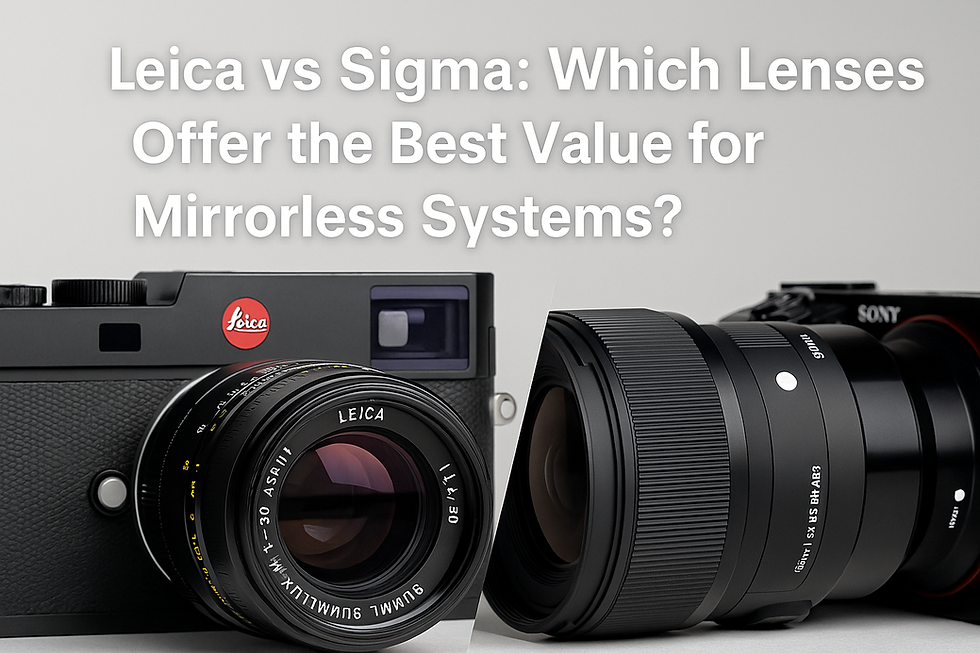Leica vs Sigma: Which Lenses Offer the Best Value for Mirrorless Systems?
- SIGMA Photo
- Apr 14
- 3 min read

In the evolving world of mirrorless photography, selecting the right lens is crucial for capturing stunning images. Two prominent players in this arena are Leica and Sigma, each offering unique advantages. This article delves into a comprehensive comparison between Leica and Sigma lenses, focusing on their compatibility with Sony mirrorless cameras, to help you make an informed decision.
Understanding Leica and Sigma Lenses
Leica Lenses:
Leica, a German brand, is renowned for its precision engineering and exceptional image quality. Leica lenses are often associated with:
Superior optical performance
Robust build quality
Premium pricing
These lenses are favored by professionals who prioritize image fidelity and are willing to invest in high-end equipment.
Sigma Lenses:
Sigma, a Japanese manufacturer, offers a diverse range of lenses that balance performance and affordability. Notable features include:
High-quality optics at competitive prices
Compatibility with various camera mounts, including Sony E-mount
Innovative designs catering to different photography styles
Sigma's commitment to delivering value makes it a popular choice among both amateurs and professionals.
Performance Comparison: Leica vs Sigma
Image Quality:
Leica lenses are acclaimed for their exceptional sharpness, contrast, and color rendition. They often produce images with a distinctive character that appeals to discerning photographers.
Sigma lenses, particularly those in the Art series, have closed the gap significantly, offering impressive sharpness and minimal aberrations. For instance, the Sigma 35mm f/1.4 DG DN Art lens delivers outstanding image quality suitable for various applications.
Build and Design:
Leica lenses boast a classic, robust design with a focus on manual controls, catering to photographers who appreciate tactile feedback.
Sigma lenses feature modern designs with a combination of metal and high-quality plastic components. They often include weather sealing and customizable switches, enhancing usability in diverse shooting conditions.
Autofocus and Compatibility:
Sigma lenses are designed with autofocus systems that integrate seamlessly with Sony mirrorless cameras, providing fast and accurate focusing. Leica lenses, while offering exceptional manual focus experiences, may not provide the same level of autofocus performance on Sony bodies.
Value Proposition
When evaluating value, Sigma lenses often provide a compelling proposition. They deliver high-end performance at a fraction of the cost of Leica lenses. For photographers seeking quality results without the premium price tag, Sigma stands out as a practical choice.
For a detailed exploration of Sigma's offerings, you can visit their official website: sigma.
Real-World Applications
Travel Photography:
Sigma's Contemporary line, such as the 16mm f/1.4 DC DN lens, is ideal for travel due to its compact size and excellent low-light performance. For tips on utilizing these lenses effectively during travel, refer to this guide: Tips for Using SIGMA Contemporary Lenses for Travel.
Portrait Photography:
Leica lenses, like the Summilux series, are favored for portrait work, offering beautiful bokeh and rendering. However, Sigma's 85mm f/1.4 DG DN Art lens provides similar aesthetic qualities at a more accessible price point.
Expert Insights
For an in-depth comparison of Sigma camera models and their suitability for various photography needs, consider reading this article: Comparing SIGMA Cameras: Which Model Suits Your Needs?.
Additionally, for a comprehensive review of the best Sigma lenses compatible with Sony mirrorless cameras in 2025, this resource offers valuable information: Best Sigma Lenses for Sony Mirrorless Cameras in 2025.
Conclusion
Choosing between Leica and Sigma lenses depends on your specific needs, budget, and shooting preferences. Leica offers unparalleled craftsmanship and image quality, appealing to those who prioritize these attributes and are prepared for the investment. Sigma, on the other hand, provides versatile, high-performing lenses that deliver exceptional value, especially for users of Sony mirrorless systems.
For photographers seeking to pair their lenses with top-tier cameras, exploring the best Digital Camera options can further enhance their photography experience.
We'd love to hear your thoughts! Share your experiences with Leica and Sigma lenses in the comments below. If you found this comparison helpful, feel free to share it with fellow photography enthusiasts.







Comments